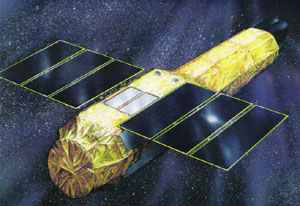The Suzaku Mission
(formerly Astro-E2)
(2005-2015)
Suzaku is Japan's fifth X-ray astronomy mission, and was developed at the Institute of Space and Astronautical Science of Japan Aerospace Exploration Agency (ISAS/JAXA) in collaboration with U.S. (NASA/GSFC, MIT) and Japanese institutions. Suzaku covers the energy range 0.2 - 600 keV and its operational scientific payload includes two co-aligned instruments. The X-ray Imaging Spectrometer (XIS) consists of four imaging CCD cameras (three working) sensitive in the 0.2-12.0 keV band, each located at the focal plane of a dedicated X-ray telescope (XRT). The second is a non-imaging, collimated Hard X-ray Detector (HXD) sensitive in the 10-600 keV band. Suzaku also carries a third instrument, an X-ray micro-calorimeter (X-ray Spectrometer; XRS), but the XRS lost all of its cryogen before routine scientific observations could begin.
After supplying key flight hardware, Goddard's current role is operating the U.S. Suzaku Guest Observer Facility (GOF). The GOF is located at NASA's Goddard Space Flight Center in Greenbelt, Maryland and is part of the Office of General Investigator Programs (OGIP) in the Astrophysics Science Division (ASD).
The primary responsibility of the U.S. Suzaku GOF is to enable U.S. astronomers to make the best use of the Suzaku mission. To fulfill this responsibility, the Suzaku GOF staff performs such activities as supporting the U.S. side of the Suzaku proposal selection process, distributing usable data to U.S. Guest Observers, helping Guest Observers to analyze their data, and creating the mission archive.
In addition to the tasks listed above, the U.S. Suzaku GOF activities include the development of software, the compilation and production of documentation for that software, and the provision of expert help. All of the U.S. Suzaku GOF's activities involve close collaboration with the Japanese Suzaku team.
Suzaku has produced an abundance of results from a wide variety of cosmic X-ray sources. Prominent recent examples:
- A comprehensive analysis of all supernova remnants (SNRs) observed by Suzaku shows the ionization state of iron in SNRs arising from thermonuclear (Type Ia) supernovae are systematically lower than that in SNRs from core-collapse explosions. This difference arises from the fact that core-collapse remnants expand into a denser local medium, significantly altered by pre-supernova mass loss, and provides the cleanest way of distinguishing the two types of remnant.
- Suzaku observations show that gas flowing out at a quarter the speed of light from the central supermassive back hole in the Ultraluminous Infared Galaxy IRAS F11119+3257 is physically connected to a molecular outflow at a large distance from the nucleus. The total mass removal rate of ~800 solar masses is sufficient to stifle star formation near the center of the galaxy.
- Suzaku detected a substantial abundance of the rare metals Mn and Ni in the spectrum of the thermonuclear (Type Ia) supernova remnant 3C 397. Only so-called "single degenerate" explosion scenarios can produce the high density needed in the progenitor core to synthesize these metals. As the "double-degenerate" scenario accounts for much of the phenomenology in other Type Ia supernovae and their remnants, this result suggests the existence of multiple Type Ia progenitor channels.
|

This page is intended for members of the scientific community. For members of the general public, or those interested in general astronomy/astrophysics information please go to our Education and Public Outreach site.
|


